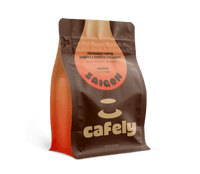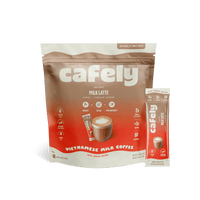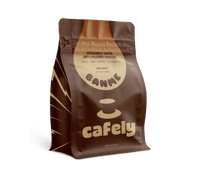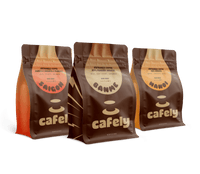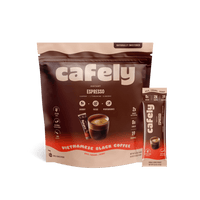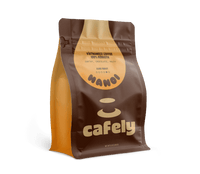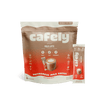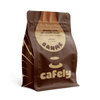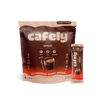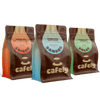Let’s address the elephant in the room — sugary drinks like Fanta Piña Colada or Barq’s root beer are some of the most unhealthy drinks on the planet and definitely not good for your health. Consuming even just one 12-oz can of your favorite soda easily exceeds the recommended daily added sugar limit — which is around 10% of your daily calorie intake.
In this article, we gathered 100 of the most popular sodas in the US and ranked them from worst to least. We’ve also created a comprehensive table of their calorie, sugar, sodium, and caffeine content.
Curious to know what is the #1 worst soda on our list, or what is the unhealthiest soda? Then read on!
For a quick peek, here are the top 10 worst sodas in the US:
- Nitro Pepsi Draft Cola by PepsiCo, the worst soda for you
- Mountain Dew Code Red by PepsiCo
- Mountain Dew Live Wire Orange by PepsiCo
- Welch’s Grape Soda by Welch Soda
- Nehi Orange Soda by Keurig Dr Pepper
- Stewart's Orange N' Cream by Stewart's
- Mountain Dew Voltage by PepsiCo
- Mountain Dew by PepsiCo
- Mountain Dew White Out Smooth Citrus by PepsiCo
- Sun Drop by Keurig Dr. Pepper
How Much Soda Does the Average American Consume?
Americans who regularly consume sodas drink an average of 1.3 glasses (12 fl oz) of soda daily.
Soda consumption in the US declined since 1999. From a peak of 49.7 gallons per person in 1999, it dropped by 14% to 42.8 gallons per person in 2024 [26].

It should be noted that soda consumption remained relatively stable from 1980 to 1986, playing between 35.1 and 35.8 gallons per capita. By 1987, soda consumption jumped to 41.9 gallons per capita, a 17% increase from the previous year.
The Cola Wars between big rivals Coca-Cola and PepsiCo, aggressive marketing strategies, increased availability on countless store shelves, the introduction of new sodas, and the use of “diet-friendly” sugar substitute aspartame in beverages — all these may have contributed to the sudden rise in soda consumption.
Soda consumption saw its peak in 1999 before it began to decline slowly, especially after the mid-2000s.
Some factors that may have contributed to the decline include:
- Increased awareness of the adverse health effects of high sugar intake
- Changes in consumer behavior and consumption habits
- Municipalities implementing a tax on sugary drinks
Despite these issues, Americans still love sodas. The US ranked fourth among countries that consume the most soda.
Hungary consumed the most at 310 liters per capita in 2019. Belgium and Argentina ranked second and third at 272 and 155 liters per capita, respectively. Ranking 4th, the US is only one liter per capita shy of Argentina, with 154 liters per capita. Chile landed fifth, with 141 liters per capita [7].

What Percent of Americans Drink Soda?
Nearly 2 in 3 (63%) adults in the US drink sugar-sweetened beverages per day, says the Centers for Disease Control and Prevention [15]. Some even consume more than one serving daily.
A 2024 survey also found that older people aged 50 to 64 years consume the most soda, with nearly 3 in 5 (58%) drinking sodas regularly [3].
Younger adults aged 18 to 29 consume the least. A little over 1 in 2 (51%) of them regularly drink sodas.
The CDC’s 2019 report also shows that 15.1% of adolescents (Grades 9 to 12) regularly consume soda at least once daily, with 11th graders consuming the most (16.8%) and 12th graders consuming the least (13.9%). More boys (18.2%) drink sodas than girls (11.7%) [22].

How Unhealthy or How Bad is Soda?
Too much of something is sometimes not a good thing, and this is true for sodas.
According to Healthy Food America, regular consumption of sodas is detrimental to our health in the following ways [24]:
- One to two sodas (12 oz) per day increase your risk of hypertension by 12% and type 2 diabetes by 26%.
- Consumption of added sugar (12 to 30 teaspoons) per day increases heart disease-related death by about 33%. Consume more than 30 teaspoons per day, and you also increase your risk of cardiovascular death by three-fold.
- A sugary beverage or two carry almost twice the risk and 30% increased risk of tooth decay in children and adults, respectively.
What is the Daily Limit of Sugar, Salt, Calorie, and Caffeine Intake?
The Dietary Guidelines for Americans says we should limit our calories from added sugars to only about 10% or less of our total calories per day [13].
Added sugars are simply sugar added to food and beverages during processing. These can be table sugar, honey, syrup, or sucrose. They don’t include the naturally occurring sugars in fruits, vegetables, or milk.
However, our ideal daily calorie intake depends on weight, age, metabolism, diet, and health status.
As a general guide for nutrition advice and labels, the FDA recommends a 2,000-calorie limit per day [9]. Based on this, the calorie limit from added sugars should only be about 200 calories per day, which is 10% of the 2,000-calorie limit.
Now, one gram of sugar contains four calories [1]. The 200-calorie cap then limits us to 50 g of added sugars per day.
The American Heart Association (AHA) recommends an even lower added sugar daily limit [17]:
- 6 teaspoons for women or 25 grams of sugar (100 calories)
- 9 teaspoons for men or 36 grams of sugar (150 calories)
When looking at the nutritional facts of a product, don’t just focus on its added sugar content. You should also check the % Daily Value (DV). A %DV of more than 20% means the food is a high-added sugar source. DV of less than 5% means it’s a low source of added sugars [8].
As for sodium limit, the AHA also recommends a sodium intake of no more than 2,300 mg per day. However, the ideal limit for most adults should be no more than 1,500 mg of sodium daily [16].
The sodium content of sodas usually ranges between 35 mg and 100 mg. Its %DV may seem insignificant, but can become a problem if you consume several sodas and salty foods daily.
It’s generally safe to consume 400 mg of caffeine daily. This is equivalent to about four to five cups of coffee, with one cup containing about 80 to 100 mg of caffeine [29]. However, consuming more than 400 mg of caffeine can cause some negative side effects [23].
The negative side effects of having too much caffeine may include:
- Fast heartbeat and increased blood pressure
- Insomnia
- Headaches
- Dizziness
- Anxiety and restlessness
Caffeinated sodas (12 oz) usually contain around 30 to 40 mg [29]. Again, their caffeine levels may seem insignificant. However, they can quickly pile up when you drink more than one soda (or energy drinks, for that matter) per day.

With these out of the way, let’s get down to the nitty-gritty.
What is the worst soda for you? How much sugar, calories, sodium, and caffeine can one drink contain?
Top 10 Sodas in the US to Avoid and Why
We gathered 100 popular sodas in the US and ranked them from worst to least unhealthiest drinks based on their sugar, calories, sodium, and caffeine contents per 12-fl oz serving.
Here’s what we found…
Note: Exercise minutes are based on the average self-reported weight of American adults of 181 lbs [28]. Men can weigh 20 lbs more than the average, while women can weigh 20 lbs less.
1. Nitro Pepsi Draft Cola by PepsiCo, the Most Unhealthy Soda

Marketed as the first nitrogen-infused cola, PepsiCo’s Nitro Pepsi Draft Cola has quickly captured the market’s attention. It has a creamy and smooth texture that’s sure to ease your sweet tooth. However, it’s also the worst soda in the country.
If you’re wondering what soda has the most sugar, Nitro Pepsi Draft Cola ranks first on our list. It has the highest sugar content per 12 fl oz serving with 55 g [30].
One whole can (13.65 fl oz) already contains more than the recommended added sugar limit of 50 g daily with 62 g. It’s 125% of your daily limit. The highest sugar soda, drinking a can is like eating six Original Glazed Krispy Kreme donuts in one sitting [19].
Nitro Pepsi also has the second highest calories with 202 and the second highest sodium content per 12 fl oz of 123 mg. It will take about 38 minutes of fast walking to eliminate the extra calories.
As for how much caffeine in Pepsi Nitro, a 12-oz serving has 68 mg of caffeine and is considered moderate strength.
If you’re wondering what is the most unhealthy soda in the US, the Worst Drink title goes to Nitro Pepsi Draft Cola.
2. Mountain Dew Code Red by PepsiCo

This luscious drink offers the refreshing taste Mountain Dew is known for but with a rush of tart and sweet cherry.
Enticing this soda may be, but this is the second worst soda to drink on our list.
That said, how much sugar is in a Mountain Dew Code Red?
Mountain Dew Code Red lands second on our worst soft drinks list. With just one drink having 92% DV, you've almost already reached your daily sugar limit of 46 g [31]. It will also take about 28 minutes of fast walking to burn off the extra 170 calories.
How much caffeine is in a 12 oz Mountain Dew Code Red?
Code Red is one of the worst drinks with the highest caffeine content [5]. It’s 1.3 times higher than the other caffeinated sodas on our list (median of 41 mg of caffeine).
3. Mountain Dew Live Wire Orange by PepsiCo

Mountain Dew with a blast of fresh orange — who wouldn't love this sugary treat? It definitely delivers what it promises. You’ll immediately feel refreshed after a drink or two, despite some saying this has more of an artificial orange flavor than a natural one.
You may have felt refreshed for a while, but you'd have to do some fast walking for 30 minutes to lose the extra calories. Mountain Dew nutrition label shows Live Wire Orange comes packed with 180 calories and a whopping 46 g of added sugar [31].That’s 11 teaspoons of sugar in one sitting! Or 22 teaspoons if you consume a couple of cans per day.
It’s also an orange soda with caffeine. One 12-oz serving has 54 mg of caffeine, equivalent to about half a cup of coffee.
4. Welch’s Grape Soda by Welch’s

Compared with other grape soda brands, Welch’s Grape Soda actually uses real grape juice. It’s no surprise that it’s one of the top sodas in the US.
Real grape juice or not, this all-time favorite grape-flavored soda lands fourth on our top ten sodas to avoid. One 12 oz can of this grape soda contains 51 g of sugar [18]. It will also take you more than half an hour on the treadmill to lose the extra 190 calories.
5. Nehi Orange Soda by Keurig Dr Pepper

Light, bubbly, and all the goodness of orange sodas, Nehi Orange Soda has captured the heart of America, especially the South. This soda was one of the most popular soft drinks during the late 1920s. However, it nearly disappeared when the Great Depression hit.
Nehi Orange Soda may have lost some of its popularity as new competitors popped up, but it remains well-loved by many.
If you're a fan of Nehi Soda Orange, then heads up. This soda is one of the top 5 worst drinks for your health. It comes loaded with high calories and sugar at 190 and 50 g, respectively [20]. One bottle of this sugary orange soda, and you’ve already maxed out your daily added sugar limit.
6. Stewart's Orange N' Cream by Stewart's

Stewart's Orange N' Cream’s rich blend of refreshing orange and cream already makes the mouth water. Who wouldn't want one, right?
Of the sodas ranked, Orange N' Cream ranked sixth. One can of this soda contains 45 g of sugar, which is like consuming about 11 teaspoons of sugar in one sitting [20]. If you drink two cans daily, it’s 29 minutes of mild-intensity spinning to lose the extra calories.
7. Mountain Dew Voltage by PepsiCo

The soda brand markets Voltage as the Dew with the mouth-watering raspberry, citrus fruit, and ginseng blend. However, people describe its flavor as a “weak” Pepsi Blue.
Weak Pepsi Blue or not, this particular Mountain Dew ranked seventh on our list of worst sodas. So, why is Mountain Dew bad for you?
This soda contains 46 g of sugar which exceeds the daily 40 g added sugar limit. It also has 170 calories, which is already about 8.5% of your daily 2000-calorie limit.
The Mountain Dew Voltage caffeine content of 55 mg is also higher than most caffeinated sodas on our list [30].
8. Mountain Dew by PepsiCo

One of the most popular sodas, Mountain Dew’s market share was about 6.8% in 2021. It has remained pretty stable between 6.6% and 7.2% in the last decade [27].
This soda may be a crowd-pleaser, but is Mountain Dew bad for you? How much caffeine does a can of Mountain Dew have?
With 54 mg of caffeine, it has one of the highest caffeine levels on our list [5]. When comparing Mountain Dew caffeine vs coffee, drinking two cans of Mountain Dew is equivalent to a cup of coffee.
How much sugar is in a 12 oz can of Mountain Dew?
It ranks fifth on our list of sodas with the highest sugar content per 12 oz with 46 g [31]. The Mountain Dew sugar content is equivalent to eating 11 teaspoons in one serving.
9. Mountain Dew White Out Smooth Citrus by PepsiCo

This citrus soda boasts sweet, citrusy, and lemongrass flavors. Mountain Dew White Out Smooth Citrus offers a refreshing flavor. But people are quick to point out that this one tastes more like its competitor, Sprite.
Is this particular Mountain Dew bad for you?
The amount of sugar in Mountain Dew White Out Smooth Citrus as well as its calories, sodium, and caffeine levels are no different from that of regular Mountain Dew [10]. As such, it also lands a spot in the top 10 worst sodas on our list.
10. Sun Drop by Keurig Dr Pepper

Does Sun Drop have caffeine?
Landing 10th spot, Sun Drop has the third-highest caffeine content on our list, with 64 mg [5]. It’s 1.6 times higher than the other caffeinated beverages on our list (median of 41 mg).
With its high sugar content of 45 g, drinking one Sun Drop means consuming about 11 teaspoons of sugar in one sitting [6].
What Soda Has the Most Calories?
These popular sodas have the most calories. Consuming a can could mean you’ve already used up at least 9% to 11% of your daily calorie intake. If you’re not monitoring your intake, the soda calories could quickly add.
Top 5 sodas with the most calories per 12 fl serving:
- 215 calories: Henry's Humdingers Hard Ginger Ale
- 202 calories: Nitro Pepsi Draft Cola
- 192 calories: Henry's Humdingers Hard Soda
- 190 calories: Welch's Grape Soda, Nehi Orange Soda, Nehi Peach Soda
- 180 calories: Mountain Dew Live Wire Orange, Stewart's Orange N' Cream, IBC Cream Soda, Sunkist Peach Flavored Soda, Nehi Grape Soda, Jones Soda Root Beer, Dr. Brown's Black Cherry Soda
What Soda Has the Most Sugar?
Health authorities recommend limiting our intake to no more than 50 g of added sugar per day. But if you enjoy drinking a can or more of these sodas daily, know that you’d already be exceeding your daily allowance. That said, which soda has the most sugar?
Top 5 sodas with the most sugar content per 12 fl serving:
- 55 g of added sugar: Nitro Pepsi Draft Cola, soda with the most sugar
- 51 g of added sugar: Welch's Grape Soda
- 50 g of added sugar: Nehi Orange Soda and Nehi Peach Soda.
- 47 g of added sugar: Nehi Grape Soda
- 46 g of added sugar: Mountain Dew Code Red, Mountain Dew Live Wire Orange, Mountain Dew Voltage, Mountain Dew, Mountain Dew White Out Smooth Citrus, Sunkist Peach Flavored Soda, Mello Yello, A&W Cream Soda, Jones Soda Root Beer, Fanta Mango
What is the Most Sugary Soda?
Nitro Pepsi Draft Cola (ranked 1st) is the most sugary soda on our list of 100 popular soft drinks. It has 55 g of sugar per 12-oz serving (110% DV). This is 1.5 times more than the recommended added sugar limit of 40 g per day. It also has the highest calorie content of 202 calories, which is 10% of the daily 2000 calorie limit.
Which Soda Has the Least Sugar?
Wondering what soda has the least amount of sugar? Well, barring sugar-free and diet sodas, the soda with the lowest sugar content on our list is Pepsi’s Orange Slice with its 1 g of sugar.
Which Soda Has the Most Sodium?
The sodium content of sodas may not seem much, but they can pile up if you’re drinking more than a can a day. Drinking two Powerade Blue Raspberry Cherry, for example, already puts you 20% nearer the daily sodium limit of 1,500 mg [25].
Top 5 worst sodas for you in terms of sodium content per 12 fl serving:
- 150 mg of sodium: Powerade Blue Raspberry Cherry
- 123 mg of sodium: Nitro Pepsi Draft Cola
- 105 mg of sodium: Mountain Dew Code Red
- 85 mg of sodium: Mexican Coca-Cola and Sunkist Diet Orange Soda
- 75 mg of sodium: Stewart's Orange N' Cream and Orange Slice
What is the Most Caffeinated Soda?
We should limit our intake to no more than 400 mg of caffeine. But if you love your coffee and these sodas, know that they put you nearer the daily limit. That said, what is the most caffeinated soda in the US?
Top 5 sodas with most caffeine content per 12 fl serving:
- 69 mg of caffeine: Pepsi Zero Sugar, soda with the most caffeine
- 68 mg of caffeine: Mountain Dew Zero Sugar and Nitro Pepsi Draft Cola
- 64 mg of caffeine: Sun Drop
- 56 mg of caffeine: Mountain Dew Dew-S-A with 56 mg.
- 55 mg of caffeine: Mountain Dew Voltage and Mountain Dew Major Melon
Related: How Much Caffeine in Coke?
Are Zero Sugar Sodas Healthy Soft Drinks?
Most diet and zero-sugar sodas on our list use aspartame as a sweetener. Compared with regular sugar, aspartame is 200 times sweeter but has zero calorific value [11]. Sugar, on the other hand, has four calories per gram [1]. However, studies show aspartame isn’t as healthy as we think.

Why is Diet Soda Just as Bad as Regular Soda?
Diet sodas may help save you from extra calories and sugars. But if you think they’re healthier and will also help you lose weight, think again. According to a review of studies done in 2017, consuming artificial sweeteners showed no significant effects on lowering BMI [2]. Instead, regular consumption of diet sodas with artificial sweeteners resulted in a modest BMI and weight circumference increase.
Artificial sweeteners also increase the risk of developing the following health problems:
- Metabolic problems like obesity and type 2 diabetes
- Heart problems like hypertension and cardiovascular events
- Stroke
Some studies also suggest that consuming high amounts of aspartame regularly can increase cancer risk. Compared with people who don’t use artificial sweeteners, regular consumption of aspartame increases the risk of serious health disorders [12]:
Health risks of aspartame include:
- Increased breast cancer risk by 22%
- Increased obesity-related cancer risk by 15%
- Increased overall cancer risk by 15%
How Much Aspartame is Safe Per Day?
Determining the acceptable daily intake (ADI) of aspartame depends on one’s body weight. In the US, the ADI of aspartame is 40 mg per 1 kg (2.2 lbs) of body weight per day [4].
Let’s use 181 lbs again as an example to calculate aspartame’s ADI, the average self-reported weight of adults in the US [28].
First, convert 181 lbs to kg (82 kg), then multiply by 40, giving you 3,280 mg per day. This means it’s safe for a person weighing 181 lbs to consume about 3,280 mg of aspartame daily.
Now, popular diet sodas’ aspartame content can range from 19 to 125 mg [14]. According to Consumer Reports, one 12-oz can of diet soda can even contain as high as 200 mg of aspartame [21].
Let’s say a 12-oz can of diet soda contains 200 mg of aspartame, which is about 6% of the ADI of a person weighing 181 lbs. To reach the ADI, a 181-lb person must consume about 16.4 12-oz cans of diet soda in a day.
Only a few people can drink this many, and most won't even be able to reach their ADIs.
A diet soda from time to time should be okay. Switching to diet sodas to wean off of sugary drinks should also be fine.
However, it’s still best to avoid consuming high amounts of beverages with artificial sweeteners. Studies have shown these may have some adverse health effects.
What is the Healthiest Drink?
The healthiest drink is, of course, water. But when it comes to sodas, Zevia Cola (ranked 100th) is the least unhealthy with zero calories, sugar, and sodium. It also only has a moderate amount of caffeine at 45 mg per 12-oz serving.

What's the Most Unhealthiest Drink?
Ranking 1st, Nitro Pepsi Draft Cola is the unhealthiest soda on our list. Exactly how many calories in a can of Pepsi Nitro? Well, based on a 12-oz serving, it has the highest calorie content of 202 per 12-oz serving and is already 10% of your daily limit.
It’s also loaded with 55 g of sugar, exceeding the daily 40 g of added sugar limit. That’s like eating 13.75 teaspoons of sugar!
It has the highest sodium content (123 mg) of all sodas on our list, and it is the second most caffeinated soda with 68 mg per 12-oz serving.
Pepsi Nitro caffeine content is also one of the highest on our list at 68 mg per 12-oz serving.
If you’re wondering what soda is the worst for you, you might want to monitor your consumption of Nitro Pepsi.
What are the Worst Sodas for Your Teeth?
The worst soda for your teeth is RC Cola with a pH of 2.32, followed by Coca-Cola Classic (pH 2.37), Coca-Cola Cherry (pH 2.38), and Pepsi (pH 2.39) [48]. The lower the pH value, the more corrosive it can be on the tooth’s enamel.
However, sodas, soft drinks, colas, energy drinks, and carbonated beverages, in general, are not good for your teeth. Their high sugar levels and carbonation contribute to tooth decay.
What are the Types of Sodas?
There are basically eight types of sodas [42].
- Soda Water: This is the foundation of all sodas and is simply fizzy, carbonated water. It typically has no flavors.
- Club Soda: It’s almost similar to soda water but contains light flavorings. This is usually used as the foundation for many mixed drinks.
- Tonic Water: This is soda water with quinine, giving it a bitter flavor. It’s also used as a base for many mixed drinks.
- Ginger Ale: This is soda water with ginger and sugar and comes in three types — golden ginger ale which is darker in color and has stronger and sweeter flavors; dry ginger ale which is lighter in flavor and mixes well with many drinks, and hard ginger ale which contains alcohol.
- Ginger Beer: This one is similar to ginger ale but has bolder flavors with hints of spiciness. It is also less carbonated than ginger ale.
- Citrus Soda: These typically include citrus-flavored sodas and vary in sweetness levels. Popular citrus sodas include 7Up, Sprite, Mountain Dew, and Royal.
- Cola: This type of soda contains kola nut and has a sweet flavor. This includes famous sodas like Pepsi, Coke, Dr Pepper, and RC Cola,
- Root Beer: This soda contains the extract from the root of the sassafras tree. Some are made with sarsaparilla vine. It has a sweet, spicy flavor with cinnamon and herbal notes.
Cream soda is also a popular type of soda. This is basically sweet soda with vanilla and mimics the flavors of an ice cream float.
Of the different types, what soda has the least sugar?
Soda water has the least amount of sugar. It also has the least flavoring of all of the types.
What are the Worst Sodas in History?
Soda companies are always coming up with new drinks to attract more people and new customers. However, not all of these become a hit with the consumers. Take New Coke (released in 1985) and Crystal Pepsi (released in 1992), for example. These had very poor sales, prompting the brands to pull them from the shelves.
Below is a list of 18 sodas that failed in the market due to poor sales, weird flavors, and bad marketing [40]:
- New Coke (1985): Very small market share
- Jolt Cola (1985, discontinued in 2011, relaunched in 2017): Very high caffeine, poor sales
- Hubba Bubba Soda (1987): Failed to catch on and interest in it waned after a while
- 7-Up Gold (1987-1988): Poor sales and low customer interest
- Crystal Pepsi (1992 to 1993): Very bland flavor
- Tab Clear (1992-1994): Weird flavor with consumers saying, “it didn’t taste right.”
- OK Soda (1993-1995): Poor marketing, especially targeting the youths and teens
- Josta (1995-1999): Lack of mass appeal
- Citra (1996, rebranded as Fanta Citrus): Poor sales
- Orbitz (1997): Weird flavors and poor sales
- Mr. Green (2002-2003): Weird flavor, like Dr Pepper with ginseng
- Pepsi Blue (2002-2004): Concerns over potential cancer risks and poor sales
- Red Fusion (2002-2004): Poor sales despite heavy marketing
- dnL (2002-2005): Low public interest
- Sprite Remix (2003-2005, briefly returned in 2016): Poor sales
- Vault (2005-2011): Failed to catch the public’s interest
- Coca-Cola BlāK (2006-2008): Poor marketing
Which Brands are Known for the Worst Sodas Taste?
According to Coca-Cola’s Club Cool in Disney World, one of the worst soda flavors among its products is a non-alcoholic aperitif called Beverly [41]. It has a grapefruit, citrusy, very bitter flavor that many consumers say tastes disgusting and shocking to the taste buds. Among Pepsi’s worst soda flavors, Pepsi Mango tops the list [36].
What is the #1 Selling Soda?
Coke remains America’s #1 selling soda and enjoys a very nice margin over Pepsi [50]. It had a comfortable 19.2% of the market share (by volume) in 2023, compared to Pepsi’s 8.3%. Dr. Pepper and Pepsi follow at 8.3%, with Dr Pepper slightly ahead of Pepsi. The fourth and fifth best-selling sodas are Sprite and Diet Coke at 8.1% and 7.8%, respectively.

What are the Most Popular Sodas in America?
The most popular sodas in America by volume are Coke (19.2% of the soda market), Dr Pepper (8.34%), Pepsi (8.31%), Sprite (8.1%), and Diet Coke (7.8%) [50].
Coca-Cola and Pepsi both lead in the top 10 most popular sodas, with 95% of survey participants saying they recognize the brands. Sprite lands second place with 94%, and 7Up and Mountain Dew at third place with 93% [45].

What is the Most Popular Soda by State?
Using the top five sodas by volume, we analyzed Google Trends (2023 data) to determine the most popular sodas by state. So, what is the most popular soda by state?
Here are our findings:
- Coke is hands down the most popular soda in America and the District of Columbia.
- Coke (46) and Dr Pepper (45) are nearly tied in Oklahoma.
- Pepsi is the most popular soda in 34 states and DC.
- Dr Pepper leads in 15 states.
- Interest in Pepsi and Dr Pepper are tied in Georgia (27).
We also wanted to see if the Google Trends results align with the volume data and found that:
- Coke is indeed the most popular soda in the US, with an “interest over time” of 71.
- Pepsi (35) is the second most searched soda, but the difference with Dr Pepsi (32) is small.
- The results for Sprite (17) and Diet Coke (13) align with the volume data, and these sodas landed in fourth and fifth places, respectively.
Final Thoughts: What Are the 100 Worst Sodas in the United States?
That’s it…that’s our list of the worst sodas for you. The ice-cold soft drinks we enjoy taste good and may give us a few refreshing minutes. But consuming even one soda puts us near our daily added sugar limit. The more sugary beverages we consume, the more calories and sugars pile up. High sodium and caffeine intake may also raise our blood pressure, all of which can negatively impact our health.
So when you’re thirsty, reach for a glass of water instead. Even a cold glass of sparkling water will do!
Water is still the best beverage for your health.
FAQ: Comparing the Top Sodas in America
We’ve gathered below some of the frequently-asked questions about these top sodas in the world. These FAQs typically compare one soda to another.
1. Which Soda is Worse Coke or Pepsi?


Pepsi Original (ranked 55th) is a little worse than Coca-Cola Original (ranked 60th). It has 10 more calories, 2 g more sugar, and 4 mg more caffeine than Coca-Cola. However, Coca-Cola has 15 mg more sodium than Pepsi.
What's the worst soda for you? Is Pepsi bad for you or Coke? Well, the difference between the two is small and won’t make a significant difference in their impact on health.
2. Is Coca-Cola Worse Than Other Sodas?

There’s no single answer to this. Coca-Cola (Original) ranked 60th on our soft drinks list. While it’s worse than the diet and sugar-free sodas, it’s also better than 59 others. Caffeine-wise, it has 34 mg of caffeine and is classified as low-strength. A serving or two won’t put you anywhere near the 400 mg daily caffeine limit like Pepsi Zero Sugar’s 69 mg.
However, it has 39 g of sugar and a high %DV of 78%. A single serving puts you near the added sugar limit of 50 g per day.
3. Which is Better, Mexican Coke or American Coke?


Soda fans swear Mexican Coca-Cola (which uses cane sugar) tastes better than American Coca-Cola (which uses high-fructose corn syrup). But having ranked 26th on our list, Mexican Coca-Cola is actually a little worse than American Coca-Cola. It has 10 more calories and 1.9 times more sodium than the latter.
What pop has the most sugar then? Both Cokes have the same amount of 39 g of sugar.
4. Is One Can of Coke a Day OK?
How many sodas a day is too many? Well, a can of Coke a day is generally not considered okay. It contains 140 calories (7% of the 2000-calorie daily limit) and 39 g of sugar. Consuming a can is like eating 9.75 teaspoons of sugar in one sitting.
5. Is Coke Zero OK to Drink?

All sodas, including zero-calorie and zero-sugar sodas like Coke Zero, are not considered healthy drinks and may not be ok to drink on a daily basis. Coke Zero may contain no calories and sugar, but it does have artificial sweeteners like aspartame and acesulfame potassium. Long-term consumption of these artificial sweaters affects the liver and contributes to chronic inflammation [34–35].
6. Is Mountain Dew Worse Than Coke?


Yes. Based on our soft drinks list, Mountain Dew Original (ranked 8th) is worse than Coke Original (ranked 60th). Drinking a can of Mountain Dew is like drinking 1.2 cans of Coke Original when it comes to calories and sugar or 1.6 cans if we’re talking about caffeine.
Mountain Dew has 30 more calories, 7 g more sugar, 15 mg more sodium, and 20 mg more caffeine than Coke Original.
Mountain Dew is one of the most popular sodas in the world, but regular consumption poses health risks. That said, what are the side effects drinking too much Mountain Dew can have on you?
Some of Mountain Dew side effects include headaches, dips in mood and energy, and indigestion. Long-term Mountain Dew health risks include weight gain, diabetes, and tooth decay, and weight gain.
7. Is Sprite Healthier Than Coke?

Sprite (ranked 59th) is slightly better than Coke (ranked 60th), with 1 g less sugar and 0 caffeine. However, Sprite has 20 mg more sodium than Coke. Calorie-wise, they both contain 140 calories per 12-oz serving.
Which soda is the worst for you? Does this make Sprite healthier than Coke? Not really. The difference is negligible when we consider the overall impact of these sodas on our health.
8. Is Sprite Healthy?
Sprite may be caffeine-free, but it is generally not considered a healthy drink with its high sugar content. At 38 g per 12-oz serving, this puts you near the daily added sugar limit of 40 g.
How many calories are in Sprite?
Sprite also has 140 calories, and drinking a can or two means you’ve already consumed 7% to 14% of your 2000 daily calorie limit.
9. Is 7Up Bad for You?

7Up is also not considered a healthy beverage. It contains 38 g of sugar, placing you nearer the daily added sugar limit of 40 g. A can or two also means consuming 7% to 14% of the daily 2000 calorie limit.
Does this make 7Up better than Sprite? What is the worst soda to drink?
Nor really. Both sodas have the same sugar and calorie content. The only difference is that 7Up has 20 mg less sodium.
10. Which is Better, 7Up or Pepsi?


What is the worst soda between the two? Well, 7Up (ranked 69th) is slightly better than Pepsi Original (ranked 55th). It has 10 less calories, 3 g less sugar, and 15 mg less sodium. It’s also caffeine-free. If you’re pretty sensitive to caffeine, 7Up is a better option than Pepsi.
However, 7Up has 76% DV. With 38 g of added sugar, a single serving puts you nearer the daily limit of 40 g.
11. Is Soda Worse Than Candy?
Yes, regular sodas are generally worse than candies in terms of sugar content. But the question is — how many pieces or packs do you usually consume in a day? It’s so easy to eat more than a handful and end up consuming more sugar than in one soda serving.
The sodas on our list have, on average, around 40 g per serving, ranging between 21 g and 55 g. America’s top five candies have an average of around 29.2 g of sugar per pack [32,37–39,44,46]. You’d need to consume around 1.4 packs to match the sugar content of a regular soda serving.
Below are the top five candies in the US and the sugar content per pack.

12. Is Soda Worse Than Beer?
Is soda worse than beer? It depends on what you’re comparing. If we’re talking about sugar content, then soda is worse than beer. Beer typically contains no sugar, while the sodas on our list are packed with it (an average of 40 g per serving) [33].
Calorie-wise, a can of soda (average of 156 calories per serving) is just about the same as a can of beer (153 calories per serving) [33]. A can or two puts you 8% to 16% nearer the daily limit of 2000 calories.
Both beverages are also acidic. The lower the pH value, the more harmful they are to the teeth. But of the two, alcohol is slightly better than soda for the teeth. The pH of sodas usually ranges from as low as 2.32 to 5.24, while beer ranges from 3.9 to 4.5 [48–49].

13. What Flavor is Coke?
Coke Original is a fizzy, carbonated drink with a well-balanced blend of sweetness, bitterness, and sourness with hints of citrus fruits (lemon, lime, and orange), vanilla, cinnamon, and nutmeg [47]. Of the different Coca-Cola products, Beverly Soda is said to be the worst drink in terms of flavor.
14. What is Beverly Soda?
Beverly Soda is a non-alcoholic, carbonated aperitif released by Coca-Cola in 1969 but discontinued in 2009 [43]. It’s a type of pre-dinner drink that stimulates appetite. It has a bitter taste with citrusy, grapefruit rind flavors.
15. Where is Beverly Drink Sold?
Beverly Soda is no longer available in grocery stores, having been discontinued in 2009 [43]. However, it is available for testing at several locations:
- Disney World’s Club Cool (Orlando, Florida)
- Disney Springs’ Coca-Cola Store Rooftop Beverage Bar (Lake Buena Vista, Florida)
- World of Coca-Cola Museum (Atlanta, Georgia)
- Coca-Cola Store’s Coca-Cola Fountain (Las Vegas, Nevada)
References
- Added Sugars. (2024, May). American Heart Association (AHA).
- Azad, M. B., Abou-Setta, A. M., Chauhan, B. F., Rabbani, R., Lys, J., Copstein, L., Mann, A., Jeyaraman, M. M., Reid, A. E., Fiander, M., MacKay, D. S., McGavock, J., Wicklow, B., & Zarychanski, R. (2017). Nonnutritive sweeteners and cardiometabolic health: a systematic review and meta-analysis of randomized controlled trials and prospective cohort studies. Canadian Medical Association Journal (CMAJ), 189(28), E929–E939.
- Bashir, U. (2024, May). Consumers of soft drinks in the US 2024, by age. Statista.
- Butchko, H. H., & Kotsonis, F. N. (2013). Acceptable daily intake vs actual intake: the aspartame example. Journal of the American College of Nutrition, 10(3), 258–266.
- Caffeine Informer. (2023). Caffeine Informer.
- Caffeine Park: Discover a World of Caffeine Options. (2023). Caffeine Park.
- CarnaudMetalbox Engineering Limited. (2024, May). Can-tastic Countries: 10 Countries with Highest Soda Consumption! LinkedIn.
- Center for Food Safety and Applied Nutrition (CFSAN). (2024a, March). Added Sugars on the Nutrition Facts Label. US Food and Drug Administration (FDA).
- Center for Food Safety and Applied Nutrition (CFSAN). (2024b, March). How to Understand and Use the Nutrition Facts Label. US Food and Drug Administration (FDA).
- Curbside Pickup & Grocery Delivery. (2023). HEB.com.
- Czarnecka, K., Pilarz, A., Rogut, A., Maj, P., Szymańska, J., Olejnik, Ł., & Szymański, P. (2021). Aspartame—True or False? Narrative Review of Safety Analysis of General Use in Products. Nutrients, 13(6), 1957.
- Debras, C., Chazelas, E., Srour, B., Druesne-Pecollo, N., Esseddik, Y., De Edelenyi, F. S., Agaësse, C., De Sa, A., Lutchia, R., Gigandet, S., Huybrechts, I., Julia, C., Kesse-Guyot, E., Allès, B., Andreeva, V. A., Galan, P., Hercberg, S., Deschasaux-Tanguy, M., & Touvier, M. (2022). Artificial sweeteners and cancer risk: Results from the NutriNet-Santé population-based cohort study. PLoS Medicine, 19(3), e1003950.
- Dietary Guidelines for Americans, 2020-2025. (2021). DietaryGuidelines.gov.
- Franz, M. (2010). Amounts of Sweeteners in Popular Diet Sodas. Diabetes Self Management.
- Get the Facts: Sugar-Sweetened Beverages and Consumption. (2022, April). Centers for Disease Control and Prevention.
- How much sodium should I eat per day? (2024, January). American Heart Association (AHA).
- How Much Sugar Is Too Much? (2024, May). American Heart Association (AHA).
- Instacart. (2023). Instacart.
- Krispy Kreme Doughnut Corporation. (2013, January). Nutritional Information.
- Kroger. (2023). The Kroger Co.
- Lee, J. (2023, January). The Truth About Artificial Sweeteners. Consumer Reports.
- National Center for Chronic Disease Prevention and Health Promotion, Division of Nutrition, Physical Activity, and Obesity. (2020). Nutrition, Physical Activity, and Obesity: Data, Trends and Maps. Centers for Disease Control and Prevention.
- National Library of Medicine. (2015). Caffeine. MedlinePlus.
- Overview: Why take on sugar? Why now? (2016). Healthy Food America.
- Pay Less Super Markets. (2023). Pay Less.
- Per Capita Soft Drink Consumption - United States. (2023, October). IBISWorld.
- Ridder, M. (2023, October). US market share of the Mountain Dew brand 2022. Statista.
- Saad, L. (2021, January). Americans’ Average Weight Holds Steady in 2020. Gallup, Inc.
- Spilling the Beans: How Much Caffeine is Too Much? (2023, September). US Food and Drug Administration (FDA).
- The Facts About Your Favorite Foods and Beverages (US). (2023). PepsiCo Inc.
- Walmart. (2023). Walmart.
- Afzal, M. (2023, August). 5 Most Consumed Candies in the US. Insider Monkey.
- Alcoholic beverage, beer, regular, all. (2019). U. S. Department of Agriculture.
- Basson, A. R., Rodriguez-Palacios, A., & Cominelli, F. (2021). Artificial Sweeteners: History and New Concepts on Inflammation. Frontiers in Nutrition, 8.
- Bian, X., Chi, L., Gao, B., Tu, P., Ru, H., & Lu, K. (2017). The artificial sweetener acesulfame potassium affects the gut microbiome and body weight gain in CD-1 mice. PLoS ONE, 12(6), e0178426.
- Boone, B. (2021, September). Pepsi Flavors, Ranked Worst To Best. Mashed.
- Candies, MARS SNACKFOOD US, SKITTLES Sours Original. (2019). U. S. Department of Agriculture.
- Candies, MARS SNACKFOOD US, STARBURST Sour Fruit Chews. (2019). U. S. Department of Agriculture.
- Candies, REESE’S Peanut Butter Cups. (2019). U. S. Department of Agriculture.
- De Luce, I. (2019, August). The 18 biggest failures in soda history, from New Coke to Orbitz. Business Insider.
- Fink, B. (2024, April). This Is the Worst Coca-Cola Flavor, According to Basically Everyone. Allrecipes.
- Graham, C. (2021, July). What You Need to Know About Soda. The Spruce Eats.
- Havens-Bowen, A. (2023, October). Coca-Cola’s Beverly Aperitif That You’ve Probably Never Heard Of. Yahoo Life.
- HOT TAMALES. (2021). U. S. Department of Agriculture.
- Kunst, A. (2024, October). Most well-known soft drink brands in the United States 2024. Statista.
- M&M’s Milk Chocolate Candies. (2020). U. S. Department of Agriculture.
- Original Recipe. (2011, February). This American Life.
- Reddy, A., Norris, D. F., Momeni, S. S., Waldo, B., & Ruby, J. D. (2016). The pH of beverages in the United States. Journal of the American Dental Association, 147(4), 255–263.
- Silva, S., Oliveira, A. I., Cruz, A., Oliveira, R. F., Almeida, R., & Pinho, C. (2022). Physicochemical Properties and Antioxidant Activity of Portuguese Craft Beers and Raw Materials. Molecules, 27(22), 8007.
- Wiener-Bronner, D. (2024, June). Dr Pepper just passed Pepsi as the second biggest soda brand. CNN.
